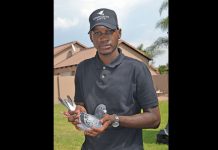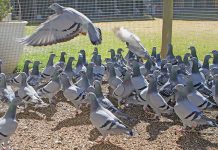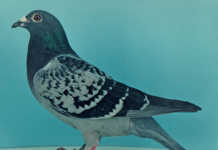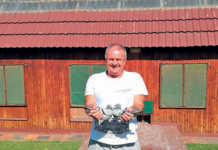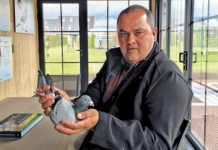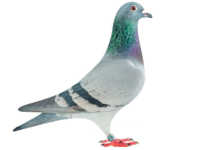Beware of the “eye sign” experts
This warning will save you cash and the heads of many good pigeons. Firstly, if a so-called “eye sign” expert examines your pigeons’ eyes and tells you which to cull, politely guide him off your property. I’ve had four generations of birds finishing in money positions in the Sun City Million Dollar Pigeon Race (SCMDPR), of which the foundation pair was disregarded by an “eye-sign” expert. After examining the pair’s eyes through a barrel-looped watchmaker’s magnifying glass, the “expert” abruptly commented, “I wouldn’t waste my time with these.” He wasn’t the first person to disregard the pair. Prior to this examination, I had the hen in my bakkie on the way to enter a pigeon show.
When I asked a friend to take the bird into the show hall for registration, he examined its external features and told me I should be ashamed of myself to put it in a public show pen. In fact, he offered to do me a favour and kill it and dispose of it in the tall grass where the fanciers were parked.Now, both these men were very convinced about their findings, but their arrogance flashed a red light for me. They didn’t bother to ask me the pigeons’ pedigree or history and ignored their genetic history and racing record. They based their findings on external examinations only. Did they think I hadn’t known to research the birds’ potential in the first place?
Judging in isolation
You should also beware of show judges who are “eye-sign” men, and will discriminate against your pigeon and mark it down if they don’t like the conformation of its eyes. In 2002, I was honoured to score 15th position in the SCMDPR with the son of the disregarded pair. In fact, it was the only entry I registered, as opposed to one entry backed by two reserves. Since then, I’ve had three top scores in subsequent generations. However, the best positions I could score at shows with these pigeons was a deserving third. What took me by surprise was that most of the points I lost were on examination of balance and muscle, with an aside that there was nothing impressive about the eyes.
The judge didn’t know my pigeon took 15th position in the SCMDPR, because show pigeons are judged anonymously. I didn’t make a scene, but I did have two questions. How could this pigeon score 15th against international competition if it had weak muscles? It took the first 250 entries a week to reach the lofts, the weather was so bad. Furthermore, how could the bird stay on-course if it had bad “eye signs”?
At pigeon shows, one learns the most about judging the external features of a racing pigeon, but nothing about genetic history and potential.
The pigeon show is nothing more than a beauty pageant. Admittedly, many show champions are also capable racing pigeons, but there are too many exceptions of “ugly ducklings” which don’t make the grade at shows, yet rewrite records in racing competitions. Don’t take pigeon shows too seriously. We have to test the birds on the merits of the racing basket. It’s called practical pigeon racing.
Beating the system
In the early 2000s I teamed up with a buddy, Johan Hamilton, after we were invited to enter our birds at a show. We dethroned the regional and national show champions in our first attempt. Twice, we won the title of National Show Champion and we won all the local club shows at the time with exceptional points margins.
We beat the system by entering the good “eye sign” pigeons into a class judged by an “eye sign” expert, the pigeon with the right muscle structure into a class judged by a “muscle man” and the bird with the right wings into a class judged by a “wing man”. We also knew some judges preferred larger or smaller types, so we entered our birds into classes to match their preferences.
No problem mating pearl to pearl
I showed my disregarded foundation pair to a champion fancier once, and he commented he wouldn’t have mated pearl to pearl. After telling him the success I had with it, he still insisted he doesn’t fancy the mating.Well, why should that be the only reason to disqualify it? Shouldn’t the many other ways physical features complement each other be considered first? Many lofts in South Africa and abroad boast champion stock of which most of the best are those with pearl eyes only. Many textbook authors over the world are against mating pearl to pearl – they’re ancient, don’t believe them.

